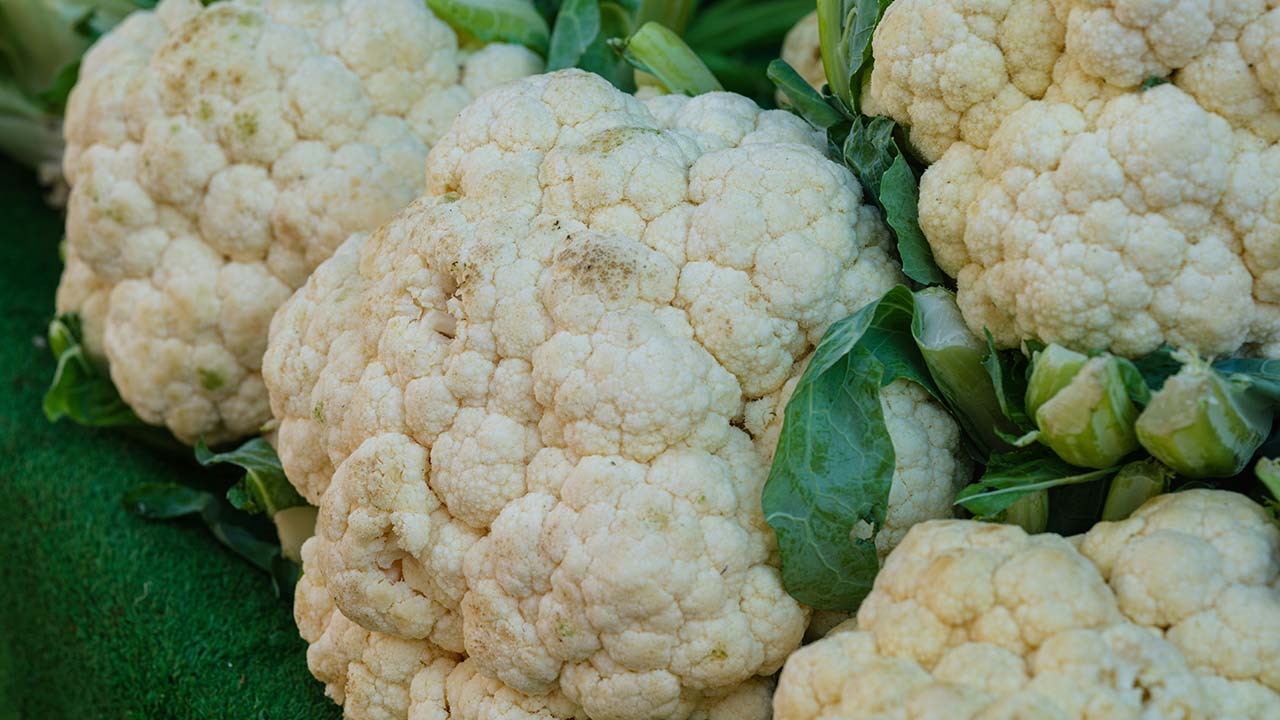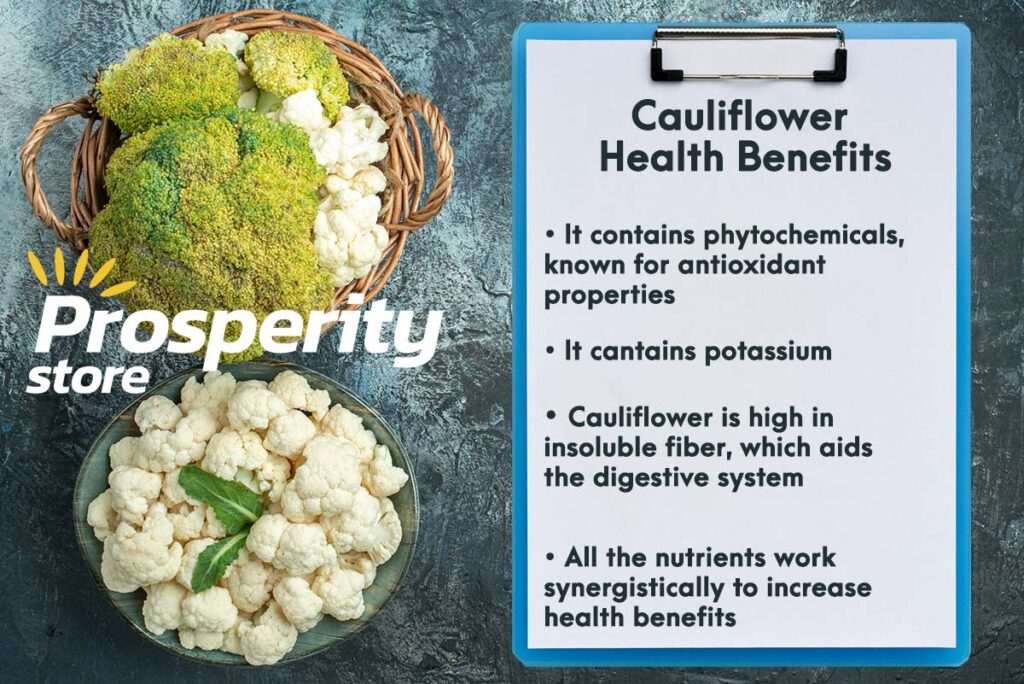Cauliflower: Health Benefits and Nutrition
Summarize

The humble cauliflower is a vegetable we take for granted, but it is loaded with phytochemicals and nutrients. With a high nutritional content, cauliflower has numerous health benefits. It is also popular because it is versatile as a cooked or raw food or an ingredient in salads, casseroles and other recipes. Cauliflower has a unique flavor and texture, too, which adds to the list of reasons this vegetable is an important addition to any diet.
What Is Cauliflower?
Cauliflower is one of the Brassica foods (Brassica oleracea, variety botrytis).
Brassica plants are categorized as cruciferous vegetables and are a plant genus in the wild mustard plant family. The cauliflower head is a cluster of undeveloped flowers.
White cauliflower is white because large leaves shade the cauliflower head from the sun, preventing discoloring from chlorophyll development. Though white cauliflower is the most common type, different cauliflower cultivars include green, purple, orange, and brown.
Due to the selective breeding of the Brassica oleracea plant, cauliflower is closely related to Brussels sprouts, kale, cabbage, collard, broccoli and more. They all evolved from the Brassica oleracea plant species, but each vegetable has a unique nutrient profile.
Cauliflower Nutrition Facts
Cauliflower is an excellent source of phytochemicals, biological compounds found in plants that support the plant’s immune systems. The vegetable is particularly high in glucosinolates, polyphenols and vitamin C. A potent antioxidant, vitamin C is known to slow down cellular aging. Cauliflower also contains carotenoids, which are also phytochemicals. An evaluation of the total phenolic content of cauliflower found that it has 77.26 mg of carotenoids in a serving, consisting of lutein and B-carotene.
Per the U.S. Department of Agriculture, a serving of 100 grams of cauliflower contains water, nitrogen (low amount), and protein and is nearly fat-free. It is high in a variety of minerals that include:
| Calcium | 20 mg |
| Magnesium | 14.2 mg |
| Irom | .33 mg |
| Phosphorus | 40 mg |
| Sodium | 20 mg |
| Zinc | .23 mg |
| Copper | .024 mg |
| Manganese | .141 mg |
Cauliflower is a superstar as a source of potassium, delivering 274 mg in a 100-gram serving.
There are even more nutrients in cauliflower. One serving of raw cauliflower has five grams of carbohydrates, two grams of protein and two grams of dietary fiber. A range of vitamins are also in this vegetable.
| Vitamin C | 48.2 mg |
| Thiamin | .05 mg |
| Riboflavin | .06 mg |
| Niacin | .507 mg |
| Pantothenic acid | .667 mg |
| Folate | 57 ug |
| Vitamin E | .08 mg |
| Vitamin K | 15.5 ug |
Cauliflower is fat-free, cholesterol-free and low in sodium. It also contains 44.3 mg of choline in one serving. Choline is not a vitamin or mineral. It is an organic, water-soluble compound needed to preserve healthy cell membranes.
The calories in cauliflower are very low. One cup of raw cauliflower contains approximately 25 calories, and a whole head of raw cauliflower contains approximately 150-160 calories. The low calories and nutritional content make cauliflower an ideal snack or meal addition.
Health Benefits of Cauliflower
With so many nutrients, it is unsurprising that cauliflower is one of the healthiest foods to eat regularly.
Phytochemicals have antioxidant properties. Vitamins and minerals are necessary to stay alive, while phytochemicals protect cells from damage due to the formation of free radicals and environmental toxins. Like they do for plants, phytochemicals support the immune system. They also protect the brain and support a healthy heart.
Cauliflower’s high amount of potassium can play an essential role in maintaining good health. Not even half of the U.S. adult population gets enough potassium in their diet, and the deficiency is possibly a major reason one-third of adults experience high blood pressure. Potassium has the potential toreduce blood pressure. Reducing high blood pressure lowers the risk of having a stroke and developing heart disease.
Is cauliflower high in fiber? Raw cauliflower is high in insoluble fiber, which aids the digestive system in moving food and reduces constipation. Fiber can lower cholesterol levels, improve blood sugar levels, support a healthy cardiovascular system and support weight loss.
When eating cauliflower, all the nutrients work synergistically to increase health benefits. Clinical studies have found that Brassicaceae plants like cauliflower have medical properties that support their use for chronic disease treatment. Cauliflower helps prevent some health issues and supports healthy system functioning.
- Antioxidant effects
- Antimicrobial
- Cardioprotective
- Anti-obesity
- Immune system modulation
- Gastro system protections
- Protects the liver (hepatoprotective)
- Prevention or improvement of anemia

Risks of Consuming Cauliflower
Each person has different health issues and unique biological systems. Consuming too much cauliflower, loaded with nutrients, may have a few negative effects.
- It might cause bloating, cramping or gas due to its fiber, raffinose (type of carbohydrate) and glucosinolates (chemicals containing sulfur) content, so anyone with chronic conditions like bowel disease or irritable bowel syndrome should avoid cauliflower.
- Avoid cauliflower if allergic to cruciferous vegetables.
- May interfere with some medications, especially blood thinners, due to high vitamin K levels.
One misconception some people have is that anyone prone to developing kidney stones should not eat cauliflower. The fact is that cauliflower is low in oxalates, so it does not increase the risk of forming calcium oxalate stone kidney stones.
Tips for Consuming Cauliflower
Is eating raw cauliflower good for you? Yes, it is good for you because all nutrients are preserved. However, cooked cauliflower is also healthy. A study of different cauliflower preparation methods found that the method used to cook cauliflower influences the nutritional content.
- Boiled cauliflower has the highest general mineral loss because the minerals leach into the water.
- Steam blanching, steam boiling, microwaving and stir-frying have the highest mineral retention.
- Water boiling and blanching leads to the most significant potassium, sodium and iron reduction.
- Calcium and magnesium usually do not easily leach during boiling or blanching because the minerals are bound to the cauliflower’s tissues.
- Water leaching can lead to up to approximately 42% of ascorbic acid (Vitamin C) loss.
- Water boiling and stir-frying lead to significant decreases in total carotenoids.
- The highest phenolic content after raw cauliflower is in steam-blanched, steam-boiled, microwaved and stir-fried cauliflower.
- To preserve flavonoids, consume raw or steam-blanched cauliflower.
Raw cauliflower provides the highest antioxidant levels, followed by steam blanching and steam boiling. The researchers concluded that cooked cauliflower retains the most phytochemicals and nutrients when steam blanched, steam boiled, stir-fried or microwaved.
How to Choose Cauliflower?
When shopping for cauliflower, look for freshness as indicated by:
- Uniform color
- Free of brown spots
- Feeling heavy
- Fresh leaves that are not wilted
In addition to the cooking methods mentioned, cauliflower can be roasted, mashed, made into soup, added to salads, turned into an appetizer or riced.

Cauliflower: The Powerhouse Food
White cauliflower is one of the most common types in grocery stores. Other colors also offer numerous cauliflower health benefits similar to white cauliflower. Purple cauliflower gets its color from a higher amount of antioxidants called anthocyanins. Orange cauliflower was cultivated to hold more beta carotene and vitamin A than the white version.
All three cauliflower colors are healthy foods. You can eat the vegetable raw or cook your favorite color of cauliflower the same way you would cook white cauliflower. This humble vegetable is a powerhouse food that should be included in every diet.
Sources
- https://www.sciencedirect.com/science/article/abs/pii/S0308814611009836
- https://www.ncbi.nlm.nih.gov/pmc/articles/PMC3542437/
- https://fdc.nal.usda.gov/fdc-app.html#/food-details/2685573/nutrients
- https://fdc.nal.usda.gov/fdc-app.html#/food-details/169986/nutrients
- https://ods.od.nih.gov/factsheets/Choline-HealthProfessional/
- https://www.uclahealth.org/news/article/what-are-phytochemicals-and-why-should-you-eat-more-them
- https://www.health.harvard.edu/staying-healthy/the-importance-of-potassium
- https://www.ncbi.nlm.nih.gov/books/NBK559033/
- https://pubmed.ncbi.nlm.nih.gov/32743821/
- https://www.niddk.nih.gov/health-information/digestive-diseases/gas-digestive-tract/eating-diet-nutrition
- https://www.ncbi.nlm.nih.gov/pmc/articles/PMC8747252/
- https://www.kidney.org/kidney-topics/kidney-stone-diet-plan-and-prevention
- https://www.ncbi.nlm.nih.gov/pmc/articles/PMC3793502/
Disclaimer: This article is for informational purposes only and is not intended to diagnose, treat, cure, or prevent any disease. Always consult a healthcare professional before changing your health or medication routine.
Share this post
